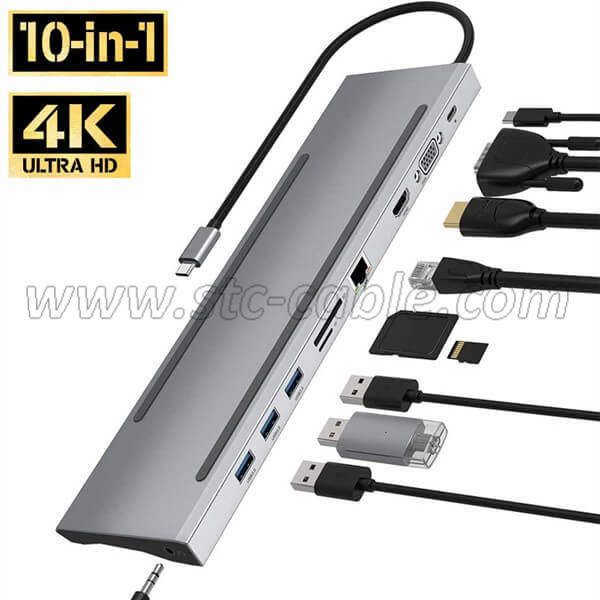What protocol does the video output from the USB-C interface use?
In the USB-C port, there are only two types that can run a large amount of data, 1 pair of low-speed lines compatible with usb2.0, and 4 pairs of high-speed lines.
The USB-C interface supports DP Alt output, and now supports up to DisplayPort 1.4 protocol video signals. HDMI Alt output is also supported, up to HDMI 1.4 protocol.
If the host side is "full-featured USB-C", the functional difference is the adapter side.
If the adapter does not have the requirement of USB 3, then USB 2 takes the low-speed line, and the 4 pairs of high-speed lines all take the DP signal, so that even if the host only supports dp1.2, it can run to 4k 60hz 10bit. It is also possible to use all 4 pairs of HDMI 1.4 signals, which is a "waste" adapter for usb2.0 + HDMI 4k 30hz.
If the USB C adapter needs to use USB 3, then 4 pairs of high-speed cables are divided into half. 2 pairs of high-speed cables can be 5G for USB 3.0/3.1 gen1/3.2 gen1, or 10G for USB 3.1 gen2/3.2 gen2. The other 2 pairs of DP, if the host only supports dp1.2 output, it can only run 4k30hz. If the host supports dp1.4 output, you can choose two among 4k, 60hz, and 10bit. Since HDMI can only use 4 pairs of wires but not 2 pairs of wires, if the adapter is USB 3 + hdmi2.0, then it must be in the adapter, and use the chip to convert the DP 1.4 output by the host into hdmi2.0 4k60hz supported, just like the "active" cable for DP to HDMI.
If the USB-C port of the host supports Thunderbolt, then the 4 pairs of high-speed lines run the two-way 40G/20G Thunderbolt protocol, and no other protocol runs directly on the cable, because the USB, DP, and PCI-e protocols are all packaged in Run in the thunderbolt protocol. If the Thunderbolt port needs to be compatible with the USB protocol, either the Thunderbolt master natively supports USB, such as the Thunderbolt master after 18 years; or a chip such as an interface multiplexer is added to the hardware. After the interface is connected, run the protocol and then put The signal is switched to the corresponding USB host or Thunderbolt host
To support Thunderbolt devices, whether it is a host interface, an adapter, or even some Thunderbolt cables, Intel's exclusive Thunderbolt chips are required. Thunderbolt 3 chips from 18 years ago, those dhl6000 and jhl6000 only support two-way dp1.2 + PCI-e 3.0 4x in the Thunderbolt protocol, so if the Thunderbolt peripherals want to support USB, you have to use the PCI-e USB host control, which is why there is a saying that Thunderbolt is not compatible with USB. After 18 years, jhl7000 natively supports 10G of USB 3.1 gen2/3.2 gen2, DP also supports 1.4, and the USB-C port of Thunderbolt master also supports DP Alt mode. In this way, the two DPs of Thunderbolt can be output separately through the USB-C DP Alt mode of the DP port and the downstream Thunderbolt port (not the MST chrysanthemum of DP).
So there are so many functions supported by the C port. How to match the protocol between the host and the device? It should be based on the PD charging protocol through the CC line in the USB-C port.
By the way, if the USB-C port is only used to run USB, then the 4 pairs of high-speed cables are actually 2-channel USB 3. For the old USB 5G protocol, which is 3.0/3.1 gen1/3.2 gen1, the dual channel is 10G, which is the legendary 3.1 gen1x2 / 3.2 gen1x2. For the new protocol that is originally 10G, which is 3.1 gen2 / 3.2 gen2, the dual channel is 20G, which is 3.2 gen2x2.
Send your message to us:
Post time: Jun-06-2022
